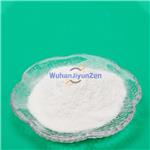Dexibuprofen, the S-(+)-isomer of the widely used NSAID agent ibuprofen, was
launched in Austria for the treatment of rheumatoid arthritis. While the racemic
compound is commonly used clinically, the antiinflammatory activity is mediated via
the S-isomer by inhibition of prostaglandin synthesis. It has also been
demonstrated that the R-isomer is converted to the Santipode in vivo via a CoA
thioester intermediate. Since CoA plays a pivotal role in intermediary metabolism
and maintenance of the [acyl-CoA], generation of R-ibuprofen-CoA competitively
inhibits many CoA-dependent reactions, which consequently produces
perturbations of hepatocyte Intermediary metabolism and mitocondrial function.
Pure S-ibuprofen usage, therefore, is preferred allowing a reduction in dosage level
and an improved side effect profile.
Ibuprofen is a non-steroidal anti-inflammatory drug with diverse biochemical actions, most notably inhibiting COX-1 and COX-2 (IC50s = 2.6 and 1.53, μM, respectively). It is commonly synthesized as a racemic mixture of (S)- and (R)-isomers. (S)-Ibuprofen is an enantiomer that more potently inhibits COX activity, thromboxane formation, and platelet aggregation than the (R)-form. (S)-Ibuprofen also inhibits activation of NF-κB more effectively than (R)-ibuprofen (IC50s = 62 and 122 μM, respectively). However, the enantiomers are equipotent in blocking superoxide formation, β-glucuronidase release, and LTB4 generation by stimulated neutrophils (IC50 values range from 0.14 to 0.58 μM). A majority of (R)-ibuprofen can be inverted to (S)-ibuprofen in humans after oral administration.
Colourless, Crystalline Solid
Ibuprofen is a non-steroidal anti-inflammatory drug with diverse biochemical actions, most notably inhibiting COX-1 and COX-2 (IC50s = 2.6 and 1.53, μM, respectively). It is commonly synthesized as a racemic mixture of (S)- and (R)-isomers. (S)-Ibuprofen is an enantiomer that more potently inhibits COX activity, thromboxane formation, and platelet aggregation than the (R)-form. (S)-Ibuprofen also inhibits activation of NF-κB more effectively than (R)-ibuprofen (IC50s = 62 and 122 μM, respectively). However, the enantiomers are equipotent in blocking superoxide formation, β-glucuronidase release, and LTB4 generation by stimulated neutrophils (IC50 values range from 0.14 to 0.58 μM). A majority of (R)-ibuprofen can be inverted to (S)-ibuprofen in humans after oral administration.
A nonsteroidal anti-inflammatory drug (NSAID); activity resides primarily in the (S)-isomer
ChEBI: Dexibuprofen is an ibuprofen. It has a role as a non-narcotic analgesic and a non-steroidal anti-inflammatory drug. It is an enantiomer of a levibuprofen.
(S)-(+)-Ibuprofen is the enantiomer associated with the anti-inflammatory action of ibuprofen, which is widely used as a nonsteroidal anti-inflammatory drug in racemic form.
Non-steroidal anti-inflammatory drug (NSAID) that inhibits cyclooxygenase 1 and cyclooxygenase 2 (IC 50 values are 12 and 80 μ M respectively). Active isomer of ibuprofen.
Potentially hazardous interactions with other drugs
ACE inhibitors and angiotensin-II antagonists:
antagonism of hypotensive effect, increased risk of
nephrotoxicity and hyperkalaemia.
Analgesics: avoid concomitant use of 2 or more
NSAIDs, including aspirin (increased side effects);
avoid with ketorolac (increased risk of side effects
and haemorrhage).
Antibacterials: possibly increased risk of convulsions
with quinolones.
Anticoagulants: effects of coumarins and
phenindione enhanced; possibly increased risk of
bleeding with heparins, dabigatran and edoxaban -
avoid long term use with edoxaban.
Antidepressants: increased risk of bleeding with
SSRIs and venlaflaxine.
Antidiabetic agents: effects of sulphonylureas
enhanced.
Antiepileptics: possibly increased phenytoin
concentration.
Antivirals: increased risk of haematological toxicity
with zidovudine; concentration possibly increased by
ritonavir
Ciclosporin: may potentiate nephrotoxicity
Cytotoxics: reduced excretion of methotrexate;
increased risk of bleeding with erlotinib
Diuretics: increased risk of nephrotoxicity;
antagonism of diuretic effect; hyperkalaemia with
potassium-sparing diuretics.
Lithium: excretion decreased.
Pentoxifylline: increased risk of bleeding.
Tacrolimus: increased risk of nephrotoxicity
Dexibuprofen is the S(+)-enantiomer of ibuprofen. After
metabolic transformation in the liver (hydroxylation and
carboxylation), the pharmacologically inactive metabolites
are completely excreted, mainly by the kidneys (90%), but
also in the bile.
Crystallise the (+) and (-) acids from EtOH or aqueous EtOH. The racemate which crystallises from pet ether with m 75-77o is sparingly soluble in H2O and has IR (film) 1705 (C=O), 2300—3700 (OH broad)cm-1. It is used as a non-steroidal anti-inflammatory. [Shiori et al. J Org Chem 43 2936 1978, Kaiser et al. J Pharm Sci 65 269 1976, J Pharm Sci 81 221 1992, Freer Acta Cryst (C) 49 1378 1993 for the (S+)-enantiomer.]
[1] JIM BARNETT . Purification, characterization and selective inhibition of human prostaglandin G/H synthase 1 and 2 expressed in the baculovirus system[J]. Biochimica et Biophysica Acta (BBA) - Protein Structure and Molecular Enzymology, 1994, 1209 1: Pages 130-139. DOI:
10.1016/0167-4838(94)90148-1[2] NICOLE SCHEUREN. Modulation of transcription factor NF-κB by enantiomers of the nonsteroidal drug ibuprofen[J]. British Journal of Pharmacology, 2009, 123 4: 645-652. DOI:
10.1038/sj.bjp.0701652[3] M. VILLANUEVA. Equipotent inhibition by R(?)?, S(+)- and racemic ibuprofen of human polymorphonuclear cell function in vitro.[J]. British journal of clinical pharmacology, 1993, 35 3: 235-242. DOI:
10.1111/j.1365-2125.1993.tb05690.x[4] A BONABELLO. Dexibuprofen (S+-isomer ibuprofen) reduces gastric damage and improves analgesic and antiinflammatory effects in rodents.[J]. Anesthesia and analgesia, 2003, 97 2: 402-408. DOI:
10.1213/01.ane.0000073349.04610.42



